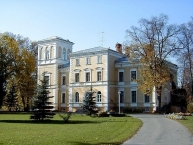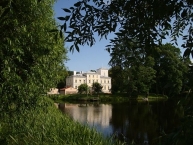Cycle Route Limbaži-Saulkrasti-Birini-Limbaži
No. of cycle route LV 109
Actions
![]()
Please wait - map data are loading
Added on 29 Aug 2014,
last edited by Ottocolor on 16 Oct 2023
Actions
Cycle route metrics
Total distance in km
93
Information about rights to the gps-track data | |
|---|---|
Rights owner | OpenStreetMap and Contributors + biroto-Redaktion (biroto.eu) |
Rights characteristic / license | Contains information from OpenStreetMap, which is made available here under the Open Database License(ODbL) |
Link to the description of the license | |
GPX file taken from | |
GPX file uploaded | by biroto-Redaktion on 16 Oct 2023
|
Track points in total
994
Track points per km (avg)
11
Start/endpoint
Start location
Limbaži, LV (74 m NHN)
End location
Limbaži, LV (74 m NHN)
Character
Latvian regional route no. 109 is a round trip in western Livonia (latvian Vidzeme) beginning and ending in the medium sized town of Limbaži. It goes south to the coastline at Saulkrasti, and from there into the countryside and then north back to Limbaži.
Information about copyright | |
|---|---|
Rights characteristic / license | by-sa: CREATIVE COMMONS Attribution-ShareAlike |
Link to the description of the license | |
taken over / edited on | 29 Aug 2014
|
taken over / edited by |
|
Beds4Cyclists, worth visiting and infrastructure
Name and address
Latitude / Longitude
Phone
Fax
Mobile
Type of accommodation
Rating for cyclists
Route km
Dist. to route
Elevation
1 km
0,2 km
66 m
16 km
0,1 km
52 m
16 km
0,0 km
49 m
Information about copyright | |
|---|---|
Rights owner | https://web.archive.org/web/20161012173922/www.panoramio.com/photo/10441656 |
Rights characteristic / license | by: CREATIVE COMMONS Attribution |
Link to the description of the license | |
Image taken over from | https://commons.wikimedia.org/wiki/File:Igates_pils_2000-10-07.jpg |
Image has been uploaded | by biroto-Redaktion on 15 Feb 2021
|
Information about copyright | |
|---|---|
Rights owner | https://web.archive.org/web/20161029183906/www.panoramio.com/user/36569?with_photo_id=2432315 |
Rights characteristic / license | by-sa: CREATIVE COMMONS Attribution-ShareAlike |
Link to the description of the license | |
Image taken over from | https://commons.wikimedia.org/wiki/File:Igate_manor_-_panoramio.jpg |
Image has been uploaded | by biroto-Redaktion on 15 Feb 2021
|
Das Schloss Igate befindet sich in Igate, Gemeinde Vidriži, Bezirk Limbaži. Es wird erstmals 1455 in Schriften erwähnt, als Idsel Diderik Fitinghof das Dorf und das Herrenhaus an Peter von der Borham verkaufte. Der Name des Herrenhauses hat sich mehrmals geändert.
Um 1880 wurde in Igate ein Herrenhaus im Neorenaissance-Stil errichtet. Das Gebäude wurde von Rudolf Heinrich Zircwitz von Pistolkors entworfen und demonstriert zurückhaltenden und raffinierten Lakonismus. 1934 wurde das Herrenhaus von der Lettischen Kinderunion gekauft und es gab ein Kinderinternat im Schloss. Im Sommer 1940 wurde es in ein Waisenhaus umgewandelt. Ab 1972 stand Igate Castle unter der Kontrolle des Landwirtschaftsministeriums. 1996 wurde Igate Castle von der State Real Estate Agency übernommen.
Information about copyright | |
|---|---|
Rights characteristic / license | by-sa: CREATIVE COMMONS Attribution-ShareAlike |
Link to the description of the license | |
Input taken over from: |
Vikipēdijas dalībnieki, 'Igates pils', Vikipēdija, Brīvā enciklopēdija, 10 jūnijs 2020, 02.56 UTC, [iegūts 15 februāris 2021] |
taken over / edited on | 20 Sep 2011 - 15 Feb 2021
|
taken over / edited by |
|
33 km
0,8 km
47 m
51 km
0,1 km
21 m
![]()


